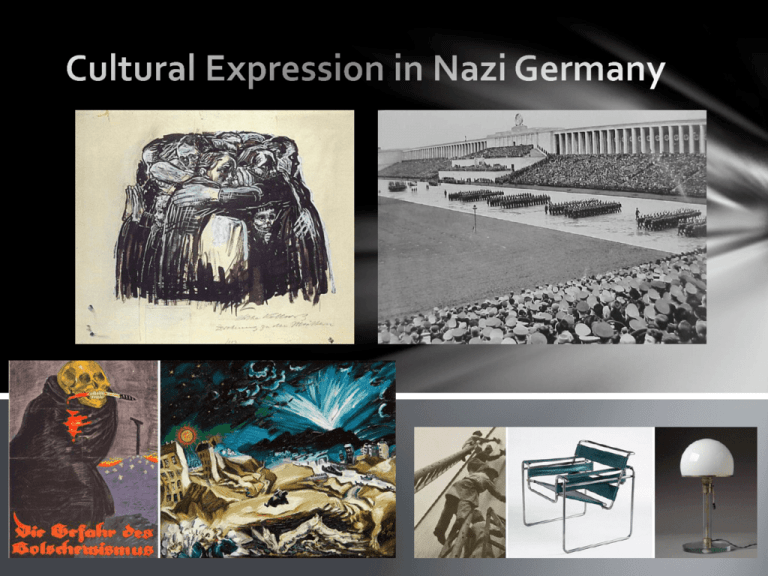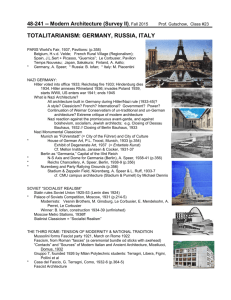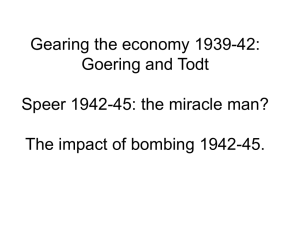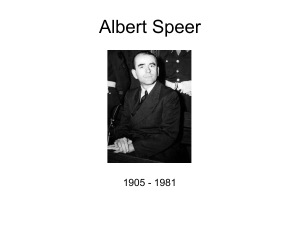Cultural Expression - Nazi Germany - vcehistory
advertisement

Learning Intentions • To understand how art was influenced by historical events in post-war and Nazi Germany. • To understand how Hitler used and abused art to fit the needs of his Nazi propaganda. • To analyse some nasty looking paintings… also chairs • To say Entarte Kunst and Otto Dix without offending anyone. Degenerate Art (entartete Kunst) Degenerate: An immoral or corrupt person. Art: The expression or application of human creative skill and imagination In Nazi Germany this term was used to describe artwork that was un-German or Jewish. An orgy of hate The world of the 1920s was like a boiling cauldron. We did not see those who fed the flames. However, we did feel the growing heat and watched the violent seething. There were speakers and preachers on every street corner. Sounds of hate could be heard everywhere. There was universal hatred: hatred of Jews, Junkers (Prussian landowners), capitalists, Communists, militarists, homeowners, workers, the Reichswehr, the Allied Control Commission, corporations and politicians. A real orgy of hate was brewing, and behind it all the weak Republic was scarcely discernible. An explosion was imminent. The world in Germany was unstable, virtually cracking, although it appeared to be happy and gay. People were deceived and believed that the joyousness had depth. Unfortunately, this was not the case. I am writing this because I was a minute part of this chaos; I was the splinter that was miraculously saved when the wood went up in the flames of the new barbarism. - Grosz, A Little Yes and a Big No Edvard Munch: The Scream (1893) Kathe Kollwitz Kathe Kollwitz's imagery is marked by poverty stricken, sickly women who are barely able to care for or nourish their children. Kollwitz's art resounds with compassion as she makes appeals on behalf of the working poor, the suffering and the sick. Her work serves as an indictment of the social conditions in Germany during the late 19th and early 20th century. Kathe Kollwitz became the first woman elected to the Prussian Academy but because of her beliefs, and her art, she was expelled from the academy in 1933. Harassed by the Nazi regime, Kollwitz's home was bombed in 1943. She was forbidden to exhibit, and her art was classified as "degenerate." Despite these events, Kollwitz remained in Berlin unlike artists such as Max Beckman and George Grosz who fled the country. http://www.mystudios.com/women/klmno/kollwitz.html ‘Self Portrait, 1924’ Modernism: Images of Despair http://www.mystudios.com/women/klmno/kollwitz.html Modernism: Images of Despair 1) What descriptive words come to mind when you view these artworks? 2) What themes are explored in these artworks? 3) What events and conditions of the 1910s and 1920s might have inspired this type of art? 4) Why do you think Hitler would have found this artwork ‘degenerate’? How did it clash with the type of Germany that he was trying to promote? Hitler: The Artist "Of course it is possible that Hitler's rejection from the Vienna Academy of Art was something that helped shape his character and turn him into the monster he became .” – Richard Westbrook-Brookes Some have speculated that Hitler's rejection from art college helped shape his character in later years. He believed that it was a Jewish professor who had rejected his application to study at the academy. "They look quite typical of an aspiring student hoping to get into art school - tentative and not very certain about his perspective when he's using pencil and pen, making basic errors by getting the top and the bottom of a candlestick wrong in relation to each other and so on … and he doesn't yet have much in the way of technical skill, but it's not so bad that one can't imagine him learning - especially when he's bolder with the charcoal or black chalk.” – Michael Liversidge http://www.telegraph.co.uk/culture/art/art-news/7511134/Hitler-sketches-that-failed-to-secure-his-place-at-artacademy-to-be-auctioned.html Hitler: The Artist Failure and resentment informed his aesthetic outlook and his loathing of Modernism related also to his hatred of the Jews and of Communism, although the pet phrase "culture-Bolshevism" to damn experimental art was ironical in view of the startlingly brutal and retrogade cultural regime which Stalin was imposing in Russia. Not that there was anything new in an enthusiasm for "healthy" and "positive" art, or the belief that "Art which merely portrays misery is a sin against the German people" - Kaiser Wilhelm II's words, not Hitler's - but the Nazis took it much further. Much of the Reich's official art was mere kitsch, and its architecture was vulgarly and oppressively grandiose, endless monuments to the fallen and, in Hitler's morbid doodlings, still huger monuments to those who would one day die for the fatherland. Some artists went into exile, either involuntarily or because they would not serve the regime, but far more did not. There were musicians who divorced Jewish spouses to keep their jobs, while great names like Strauss, Pfitzner and Furtwängler chose to endorse the regime. http://www.guardian.co.uk/books/2002/oct/19/politics.art Pearl Jam: Do the Evolution http://www.youtube.com/watch?v=aDaOgu2CQtI&ob=av2e Otto Dix hates life http://www.mess.net/galleria/dix/ Otto Dix (1891-1969), the great German Expressionist, was famous for his unique and grotesque style. Although Hitler's Nazi regime destroyed many of Otto Dix's works, the majority of his paintings can still be seen in museums throughout Germany. The Triumph of Death (1934) http://www.ottodix.org/ Degenerate Art Exhibition, Munich 1937 Hitler and the Nazi’s removed all of the Degenerate Art’ from the galleries and museums and created a ‘Degenerate Art’ exhibition to ridicule modernist artworks. http://fcit.usf.edu/holocaust/arts/artdegen.htm Leni Riefenstahl LENI RIEFENSTAHL was born in Berlin in 1902. She studied painting and started her artistic career as a dancer. An injury of the knee put an end to her sensational career. After that, she became famous as an actress, a film director, a film producer and a film reporter. She became world-renowned as an actress in the films. Her greatest success she made with the documentary film ‘Triumph des Willens’ named after the Reich Party Congress 1934 in Nuremberg. However, at the end of the war this film destroyed Leni Riefenstahl's career, for now it had no longer been recognized as a piece of art but been condemned as a National Socialist propaganda film. She would later claim that she had no experience of politics. The film she said ‘showed what was happening in front of our eyes… It is history. A purely historical film’. http://www.leni-riefenstahl.de/eng/bio.html Triumph of the Will 1) What do the images in this film/documentary show? 2) What impression do they give of Adolf Hitler, the Nazi Party and German life? 3) How is music used and what impact does it have on the audience? 4) Do you consider this to be art, propaganda or history? Why? http://www.youtube.com/watch?v=BBfYncHshJc&feature=watch-now-button&wide=1 Albert Speer Albert Speer was born in Mannheim, Germany. He was educated in architectural studies at the Institute of Technology in Karlsruhe, and later at the Universities of Munich and Berlin. Inspired by Hitler's oratory prowess, he joined the National Socialist party in January 1931, where he developed a close friendship with Hitler. He believed Hitler and the Nazis could answer the communist threat and restore the glory of the German empire that he considered lacking under the Weimar Republic. Speer quickly proved his worth by his efficient and creative staging of Nazi events. He designed monuments and decorations, as well as the parade grounds at Nuremberg where a party congress was held in 1934 and captured on film by Leni Riefenstahl in Triumph of the Will. That Nuremberg rally was the archetype of what became identifiable as a Nazistyle of public rallies as spectacles, characterized by huge crowds of uniformed marchers, striking lighting effects, and impressive flag displays directed by Speer. He was a serious man Albert Speer In 1937, Hitler gave Speer the opportunity to fulfill his youthful architectural ambitions by appointing him Inspector General of the Reich. Hitler selected Speer, his "architect of genius," to construct the Reich Chancellery in Berlin and the Party palace in Nuremberg. Hitler also commissioned him to refurbish Berlin, a project for which Speer prepared grandiose designs that were never completed. Speer was found guilty of war crimes and crimes against humanity at the Nuremberg International Military Tribunal in 1946. He had been charged with employing forced laborers and concentration camp prisoners in the German armaments industry. He was sentenced to twenty years' imprisonment in Spandau prison, after which he published his best-selling memoir, Inside the Third Reich (1970). Speer died in London in 1981. http://www.thirdreichruins.com/ Albert Speer was a bit OTT Grosse Hall - model The Master Model The Cathedral of Light http://forum.skyscraperpage.com/showthread.php?t=141374 What do you think? 1) What descriptive words come to mind when looking at Albert Speer’s architecture? 2) What shapes are most prominent in Speer’s work? The Mad Square Exhibition http://www.artgallery.nsw.gov.au/exhibitions/mad-square/ Who gives a crap? It’s a chair. The Bauhaus (1919–33) is widely considered as the most important school of art and design of the 20th century. Founded by the German architect Walter Gropius in the provincial town of Weimar the Bauhaus quickly established its reputation as the leading and most progressive centre of the international avantgarde. Gropius sought to do away with traditional distinctions between the fine arts and craft, and to forge an entirely new kind of creative designer, skilled in both the conceptual aesthetics of art and the technical skills of handcrafts. Students were assigned to a workshop – in metals, ceramics, textiles, wood, printmaking or wall painting – where they progressed from apprentice, to journeyman, to master craftsman. From the outset, the school was considered to be both politically and artistically radical. In 1925, authorities forced the school to close in Weimar because of its perceived cultural bolshevism. The Bauhaus relocated to the industrial city of Dessau and in 1928 the architect Hannes Meyer took over as director. Growing political pressure forced the Bauhaus to move again, this time to Berlin in 1932. The Nazis closed the Bauhaus permanently in 1933 after police raided what had essentially become a school of architecture under the direction of Ludwig Mies van der Rohe. The Bauhaus Chair








